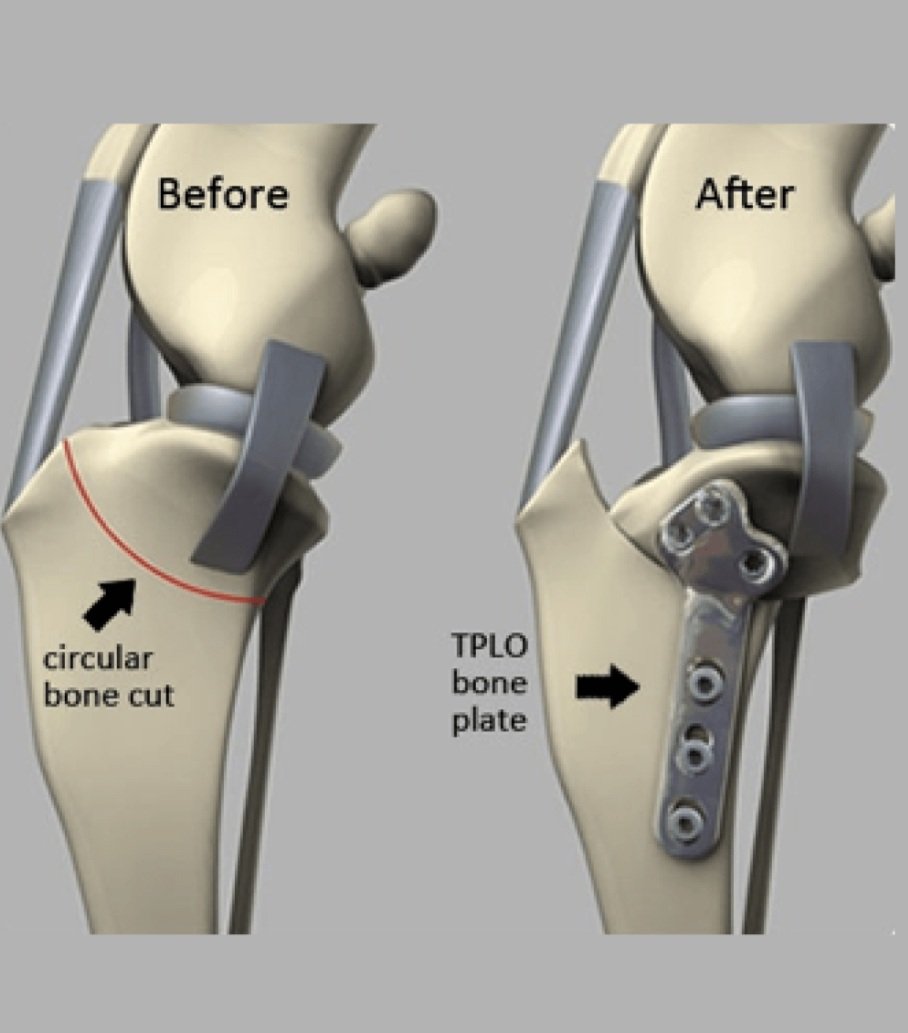 The Healthy Stifle
The Healthy Stifle
A human’s knee and a dog’s knee are similar in many regards, but also differ in some important ways. If you’re reading this standing up, chances are you’ve got at least one leg “locked” out straight holding your bodyweight. A dog will never do this - their leg is always angled.
The “ball” at the end of the femur (thigh bone) rests on the top of the tibia (shin bone), on a slope we call “the tibial plateau.” In a healthy stifle (knee) joint, the cranial cruciate ligament (CrCL or ACL) prevents the ball of the femur from sliding off the slope of the tibia, maintaining stability and a happy knee.
Cranial Cruciate Ligament Disease
It is not unfair to think of the cranial cruciate ligament (CrCL or ACL) like a high-tensile steel cable that supports a traffic bridge; a bundle of fibres woven together to make a strong whole. In humans, this can rupture spectacularly – the classic Football, Skiing or Netball injury! Whilst this can occur in dogs, it is far more typical for the ligament to undergo a longer process of disease and inflammation, the fibres in the ligament slowly fraying, until one day a not-all-that-spectacular accident causes the ligament to finally give way. Sound familiar to your dog?
Once the ligament is ruptured, there is nothing to stop the ball of the femur sliding downwards and backwards off the tibial plateau, causing instability, pain and inflammation, and damaging other structures such as meniscal cartilage in the process!
The Surgical Solution
The objective of surgery is to restore stability to the knee joint by altering the angle of this slope.
A semicircular cut (
Osteotomy) is made to facilitate
Levelling the
Tibial
Plateau. Tibial Plateau Levelling Osteotomy.
Interestingly (and unlike human ACL surgeries you may be familiar with), we don’t try to replace the Cruciate Ligament. Instead, the forces that are normally worn by the CrCL are transferred to the biggest, strongest tendon in the body; the Patellar Tendon.
The genius of the procedure
Having made the Osteotomy, the cut is then stabilised using a plate and screws. On X-rays, these implants are the impressive bit, but it’s important to note that these implants are
below the joint. If you’ve ever had a fractured bone, you’ll know that it is only painful when it’s moving (which is why a cast helps so much). Unlike some other Cruciate Ligament Repair techniques, there are no implants over or inside the joint, which helps to minimise pain and speed recovery.
Recovery
After surgery, our team will be in regular contact with you both through phone calls and check ups, to ensure a smooth recovery, and to make sure your dog's return to activity is tailored to them and to you. Generally speaking, we think of the recovery in three phases;
- 1. a short period of 2-4 days of post operative pain management
- 2. 10-14 days for the skin incision to heal (Bucket Head!)
- 3. a period of 8-10 weeks for the bone to heal. During this time, we are relying largely on the implants to hold things together, so controlled exercise (on a lead) is important.
Objectively, whilst we will always treat every animal on a case-by-case basis, you can reliably expect a return to a good quality of life, including normal play and trips to the beach!
Cost
Our promise to you is to deal with every case on an individual basis (no churn and burn here), but as a guideline, a TPLO procedure with our team costs between $6,000 and $6,250. This includes pre-operative and post-operative radiographs as required, all post-operative pain medications and check ups. We won’t surprise you with any hidden costs, and we’re very happy to collaborate with your regular vet.
Book a consultation with us, or call us on 9383 7773.